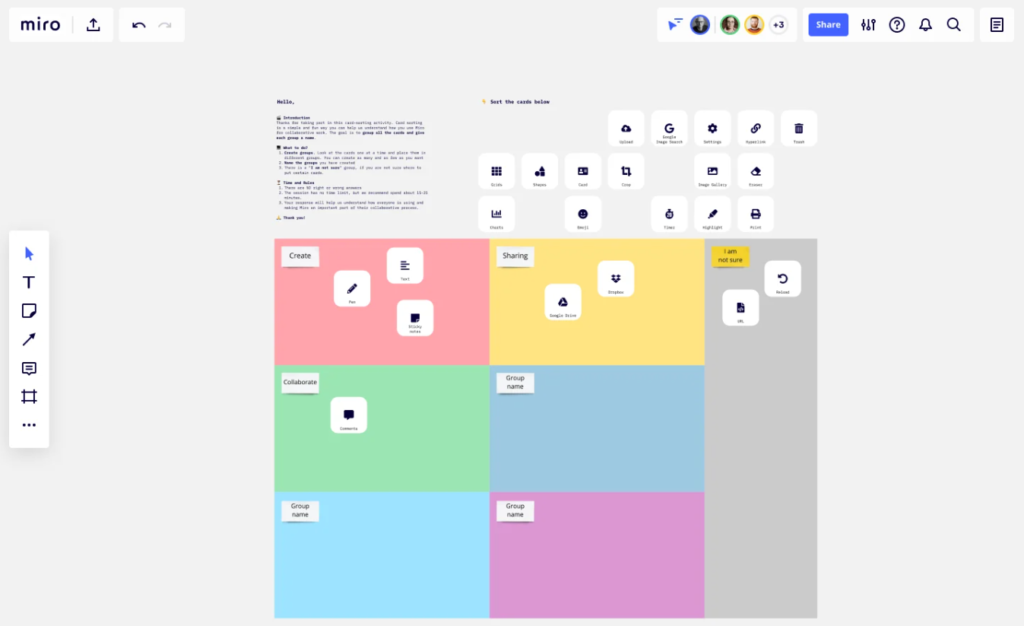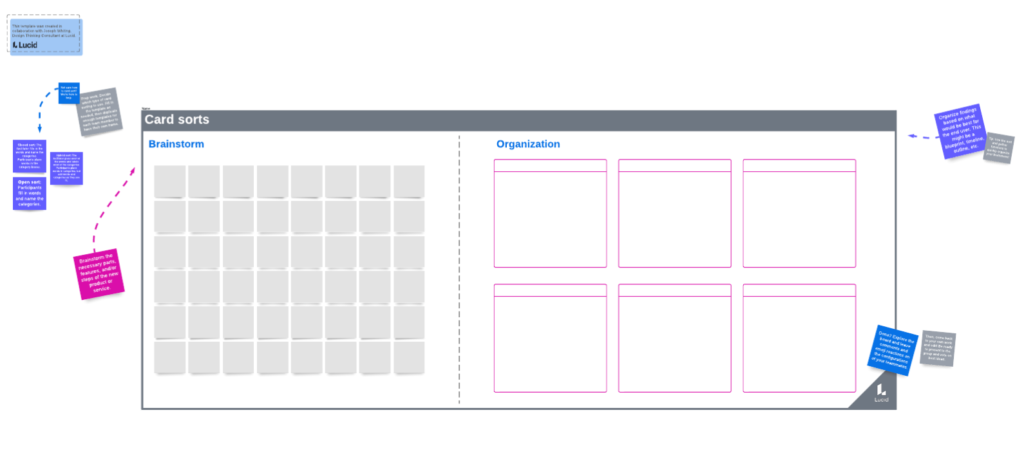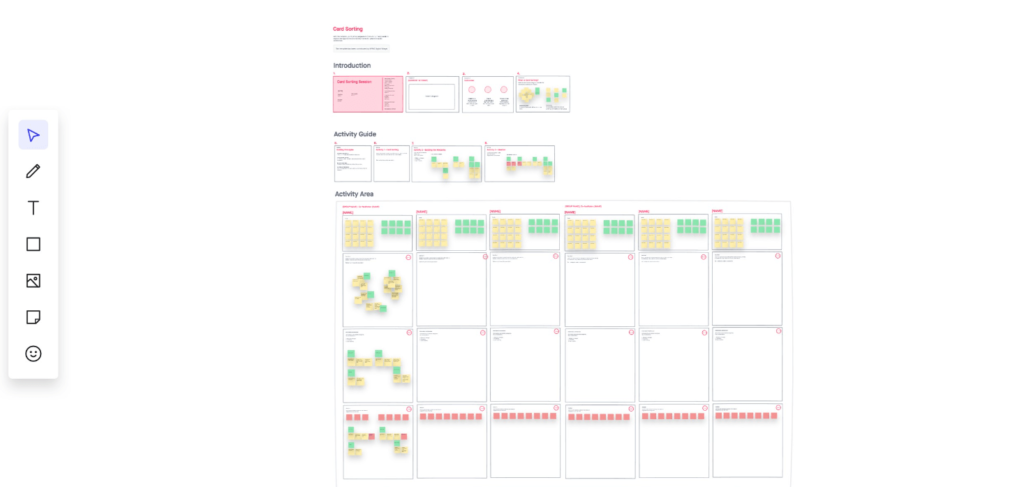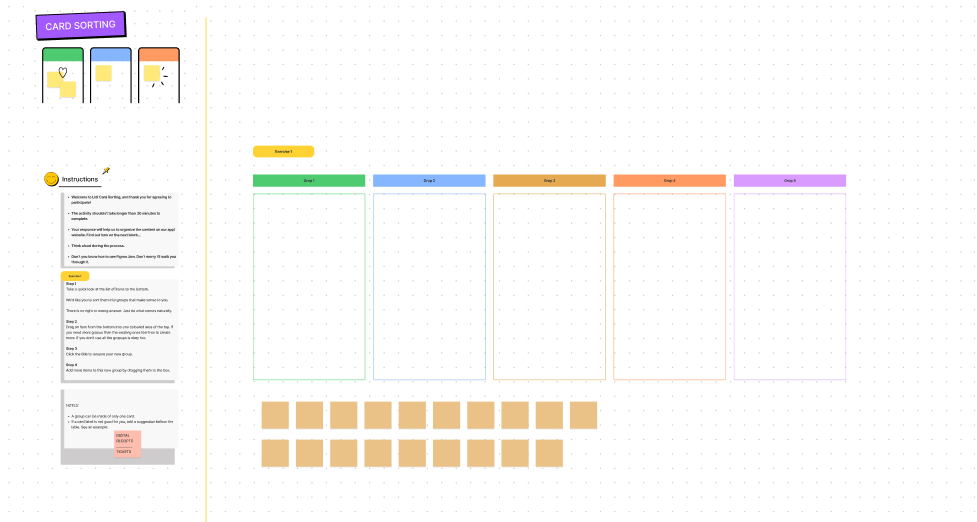Card Sorting Template
Card sorting template is a valuable asset in a toolkit of a UX researcher. With the help of card sorting you are able to explore your users’ mental models, get insights on content categorization and optimize your navigational structure to be as intuitive as possible.
By using a card sorting template to conduct your study you’re able to save some time on creating its layout, design and preparing the cards. Instead, you can focus on understanding your users and analyzing their card sorting results.
Why do you need a card sorting template?
Card Sorting template helps a lot when you decide to conduct your study without the help of online card sorting tools. Either remote or in-person, a card sorting template will ease the process of designing your card sorting study, save you tons of time and help to make it more visually appealing for the participants.
Open Card Sorting template
In open card sorting respondents are presented with a set of cards and asked to sort them into groups, which they then need to name themselves. No category names are defined in advance, you give respondents a complete control of the future content structure.
I found two great card sorting templates that would be perfect for open card sorting. However, I’d like to specify that mostly any card sorting template suitable for open card sorting is also suitable for closed one. As long as they’re editable, you can either leave the category names or ask respondents to come up with their own, like in open card sorting.
1. Miro Card Sorting template
Miro offers a card sorting template you can use inside their tool to get quick insights on your content organization. This template is great because it’s color coded and intuitive to work with for both participants and researchers as Miro makes collaboration very easy.

2. Lucidspark Card Sorting Template
Lucidspark is a virtual whiteboard that provides their users with a card sorting template that can be used for all types of card sorts. It’s very easy to edit and navigate, making it a perfect fit for Open card sorting, as participants will have no problem naming the categories.

Closed Card Sorting template
In closed card sorting participants are presented with a set of cards and specific categories to sort in. The names of the categories are predefined by the researcher and can’t be altered by the participants.
3. InVision Card Sorting template
Another popular prototyping platform, InVision offers a great card sorting template to help you make sense of your information architecture. This platform also allows for easy collaboration and is quite intuitive, so your participants won’t have problems sorting the cards.

4. Figma Card Sorting template
My favorite prototyping tool also has a handy card sorting template you can use. One of them is a template by Figma itself, and the other is more of a Plugin Template from Figma Community.
They have a slightly different structure but are both very clean and minimalistic. Using a Figma template is also a plus as its UI is very intuitive to many people.

Card Sorting analysis template
Analyzing the results of a card sorting study can be overwhelming, due to the amount of data obtained from it. However, with a good card sorting analysis template at hand you don’t have to worry about it. Below I gathered 2 card sorting analysis templates. One is a spreadsheet that’ll help you make sense of all the data and the other one is a card sorting report template.
1. Card sorting analysis template [Spreadsheet] by Donna Spencer
This first template was created by Donna Spencer, a founder of Maadmob, a small Australian freelance/consulting design studio. Donna is also an author of a well-known book on Card Sorting in the UX research community.
She shares this spreadsheet as the resource she’s been using for multiple years in her open card sorting studies. This is a great card sorting analysis template to help you make sense of all the data and organize it in an intuitive way.
2. Card sorting report template by Usability.gov
This second template was created by Usability.gov and is a perfect example of how a card sorting report should be structured in order to not overlook any important data. The template is available for free download in DOCX, you can easily customize it to suit your needs.
Online card sorting tools analyze your card sorting data and generate these PDF reports automatically, creating a customized shareable document with graphs and diagrams of your findings.
Check out how these card sorting reports look: Open Card Sorting Report, Closed Card Sorting Report and Hybrid Card Sorting Report.
Card Sorting Template
Card sorting template is a valuable asset in a toolkit of a UX researcher. With the help of card sorting you are able to explore your users’ mental models, get insights on content categorization and optimize your navigational structure to be as intuitive as possible.
By using a card sorting template to conduct your study you’re able to save some time on creating its layout, design and preparing the cards. Instead, you can focus on understanding your users and analyzing their card sorting results.
Why do you need a card sorting template?
Card Sorting template helps a lot when you decide to conduct your study without the help of online card sorting tools. Either remote or in-person, a card sorting template will ease the process of designing your card sorting study, save you tons of time and help to make it more visually appealing for the participants.
Open Card Sorting template
In open card sorting respondents are presented with a set of cards and asked to sort them into groups, which they then need to name themselves. No category names are defined in advance, you give respondents a complete control of the future content structure.
I found two great card sorting templates that would be perfect for open card sorting. However, I’d like to specify that mostly any card sorting template suitable for open card sorting is also suitable for closed one. As long as they’re editable, you can either leave the category names or ask respondents to come up with their own, like in open card sorting.
1. Miro Card Sorting template
Miro offers a card sorting template you can use inside their tool to get quick insights on your content organization. This template is great because it’s color coded and intuitive to work with for both participants and researchers as Miro makes collaboration very easy.

2. Lucidspark Card Sorting Template
Lucidspark is a virtual whiteboard that provides their users with a card sorting template that can be used for all types of card sorts. It’s very easy to edit and navigate, making it a perfect fit for Open card sorting, as participants will have no problem naming the categories.

Closed Card Sorting template
In closed card sorting participants are presented with a set of cards and specific categories to sort in. The names of the categories are predefined by the researcher and can’t be altered by the participants.
3. InVision Card Sorting template
Another popular prototyping platform, InVision offers a great card sorting template to help you make sense of your information architecture. This platform also allows for easy collaboration and is quite intuitive, so your participants won’t have problems sorting the cards.

4. Figma Card Sorting template
My favorite prototyping tool also has a handy card sorting template you can use. One of them is a template by Figma itself, and the other is more of a Plugin Template from Figma Community.
They have a slightly different structure but are both very clean and minimalistic. Using a Figma template is also a plus as its UI is very intuitive to many people.

Card Sorting analysis template
Analyzing the results of a card sorting study can be overwhelming, due to the amount of data obtained from it. However, with a good card sorting analysis template at hand you don’t have to worry about it. Below I gathered 2 card sorting analysis templates. One is a spreadsheet that’ll help you make sense of all the data and the other one is a card sorting report template.
1. Card sorting analysis template [Spreadsheet] by Donna Spencer
This first template was created by Donna Spencer, a founder of Maadmob, a small Australian freelance/consulting design studio. Donna is also an author of a well-known book on Card Sorting in the UX research community.
She shares this spreadsheet as the resource she’s been using for multiple years in her open card sorting studies. This is a great card sorting analysis template to help you make sense of all the data and organize it in an intuitive way.
2. Card sorting report template by Usability.gov
This second template was created by Usability.gov and is a perfect example of how a card sorting report should be structured in order to not overlook any important data. The template is available for free download in DOCX, you can easily customize it to suit your needs.
Online card sorting tools analyze your card sorting data and generate these PDF reports automatically, creating a customized shareable document with graphs and diagrams of your findings.
Check out how these card sorting reports look: Open Card Sorting Report, Closed Card Sorting Report and Hybrid Card Sorting Report.
